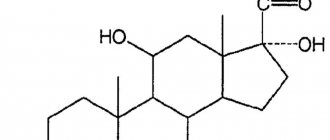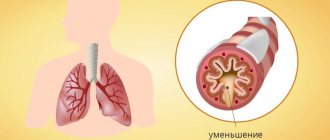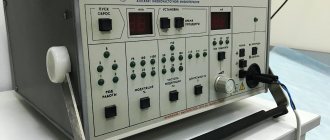The adrenal glands are endocrine glands that produce large amounts of endocrine hormones and thereby regulate many human life processes. In turn, diseases of the adrenal glands entail significant pathological changes in the body.
Each adrenal gland, a paired organ located at the upper pole of the kidney, consists of a cortex and a medulla. The cortex produces mineralocorticoids (responsible for the exchange of water and minerals in the body), glucocorticoids (metabolism and energy), and sex hormones. The medulla produces adrenaline and norepinephrine. Depending on where the pathological process arose, a corresponding picture of the disease appears.
The structure and functioning of the adrenal glands
The adrenal glands are based on two structures:
- Brain matter.
- Cortical substance.
They are regulated by the nervous system.
Brain matter
The medulla is the main source of catecholamine hormones in the body - adrenaline and norepinephrine.
Adrenaline is the main hormone in the fight against stress. An increase in its production occurs during positive and negative emotions, for example, during injury or a stressful situation.
When exposed to adrenaline, the body uses reserves of accumulated hormone, which is manifested by the following reactions:
- a sudden surge of strength;
- increased breathing;
- pupil dilation.
The person feels stronger than usual, and the pain threshold is significantly reduced.
Norepinephrine is also a stress hormone, but its production occurs before the production of adrenaline. The impact is much weaker. Its function is to regulate blood pressure, which stimulates the work of the myocardium - the heart muscle.
Cortex
The adrenal cortex consists of several layers, each of which performs a specific function.
- Mesh zone.
- Bundle zone.
- Zona glomerulosa.
Androgens, sex hormones, are synthesized in the reticular zone. They are responsible for the development of secondary sexual characteristics and influence:
- state of libido - sexual desire in men and women;
- blood cholesterol and lipid levels;
- fat deposition;
- increase in muscle strength and mass.
Regardless of gender, each body produces both male and female sex hormones. The difference is in their quantity. For example, women synthesize estrogen and progesterone, which are responsible for reproductive function - conception and birth of children, but also testosterone in a small amount, which is considered the male hormone.
What are the adrenal glands, what functions do they perform?
These are paired endocrine glands located above the upper poles of the kidneys. Each of them consists of two elements that perform different functions.
The adrenal cortex produces: • glucocorticoids, which fight inflammation and stimulate the formation of glucose in the liver; • androgens, which regulate the functioning of the main sex hormones; • mineralocorticoids, which are responsible for the transport of electrolytes.
The second element, the medulla, produces catecholamines that regulate the basic reactions of the sympathetic nervous system. The most obvious manifestation of the work of these glands is the release of adrenaline.
Beam zone
This zone is responsible for the synthesis of glucocorticosteroids. They are responsible for protein, carbohydrate and fat metabolism in the body. Closely related to the production of insulin and catecholamines.
Glucocorticosteroids reduce the immune response, inhibit inflammatory processes, gradually suppressing them.
One of the hormones in the zona fasciculata is cortisol. It takes part in carbohydrate metabolism and preserves the body's energy resources. The level of cortisol in the body is constantly changing - there is more of it in the morning than in the evening or at night.
Zona glomerulosa
The zona glomerulosa of the adrenal cortex is responsible for mineral metabolism in the body. The hormones produced here normalize the functioning of the renal tubules, so excess fluid leaves the body, which, in turn, keeps blood pressure levels normal.
The following hormones are secreted in the zona glomerulosa:
- Aldosterone. Its function is to maintain the balance of sodium and potassium ions in the blood. The hormone takes part in water-salt metabolism, improves blood circulation, and increases blood pressure.
- Corticosterone is a hormone with low activity and is involved in mineral balance.
- Deoxycorticosterone also regulates water-salt balance, gives strength to the skeleton and muscle tissue.
The adrenal glands are a “factory” of hormones
The adrenal glands are small paired organs located, as the name suggests, above the kidneys. Their main task is to produce hormones - substances that regulate all vital processes in the body. For example, glucocorticoid hormones are responsible for metabolism, mineralocorticoid hormones are involved in water and salt metabolism, androgens and estrogens are analogs of sex hormones, adrenaline and norepinephrine are stress hormones. The adrenal glands are surrounded by a dense connective tissue capsule and are embedded in adipose tissue. Bundles of the capsule (trabeculae) penetrate into the internal parts of the gland, forming partitions that divide the organ into layers and zones. The adrenal glands are, in addition, surrounded by the renal fascia, to which they are connected very firmly. The right adrenal gland has the shape of a truncated cone, flattened from front to back. From the front it resembles a triangle with rounded corners - “Napoleon's tricorne”. The apex of the left adrenal gland is flattened and is shaped like a crescent. Front view of isolated right and left adrenal glands
How do adrenal gland diseases manifest?
When the balance of hormones in the body is disturbed, its functioning occurs. Symptoms appear according to a dependence pattern, that is, a specific substance produced in the adrenal glands is responsible for a symptom unique to it. For example, with aldosterone deficiency, sodium is excreted from the body along with the urine, which lowers blood pressure and significantly increases the potassium content in the blood.
To avoid serious consequences, you need to consult a doctor at the first signs of adrenal disease. These include:
- muscle weakness;
- constant fatigue;
- severe weight loss is a consequence of decreased appetite;
- low stress resistance;
- high irritability;
- rapid and constant fatigue;
- sleep problems;
- dizziness, headaches.
Next, the most common diseases of the adrenal glands, which have their own symptoms and causes, require specific treatment tactics.
Surgical treatment of adrenal diseases:
Currently, operations on the adrenal glands can be performed using traditional “open” access, or using high-tech methods (endoscopic operations). The standard access for adrenalectomy is most often lumbotomy or laparotomy - quite traumatic and time-consuming interventions. Such approaches as transdiaphragmatic, subdiaphragmatic, transthoracic can also be used. The Center for Endocrine Surgery widely uses endoscopic techniques in adrenal surgery, which can be either laparoscopic or extraperitoneal access. Endoscopic techniques are less traumatic compared to “open” surgery: in endoscopic operations there are 3 or 4 punctures of 1 cm each, patients spend less time in hospital treatment, recovery time is reduced by 2-3 times. The type of surgery is most often determined by the size of the tumor.
Addison's disease
Other names for Addison's disease are primary adrenal insufficiency and hypocortisolism.
A rare pathology, accounting for 50–100 cases per million per year. It is diagnosed in both women and men. Average age is from 20 to 40 years.
The disease affects all three zones of the adrenal cortex. Characterized by a deficiency in the production of corticosteroids. Violation of hormone synthesis causes serious complications in the body.
The cause of destruction of the adrenal cortex is pathogenic microorganisms that have entered the body - viruses, bacteria, fungi, as well as immune disorders.
Manifestations of Addison's disease:
- decreased blood pressure;
- fatigue, weakness, lack of physical strength;
- lack of appetite;
- disruption of the digestive system;
- pigmentation of the skin, the appearance of dark spots on the mucous membranes;
- chills;
- increase in body temperature.
To identify the disease, it is necessary to take tests to measure the level of cortisol in the blood. The condition of the adrenal cortex and the functioning of the glands are examined.
Treatment is taking medications containing corticosteroids throughout life. It is possible to administer hydrocortisone intramuscularly.
Adrenal dysfunction. Tired Man, continued...
Murzaeva Irina Yurievna
Endocrinologist, Preventive Medicine Doctor
October 26, 2017
Dysfunction is like a pre-disease. The disease has not yet developed, but there are complaints, but they are erased, so the person feels bad, but he cannot understand what is wrong with him and with which organ this condition can be associated.
In modern society, an incorrect tendency of social behavior is being formed. You are constantly being pushed “more, more……. work more, be successful, have a career, but don’t forget about your family, have 2-3 children (we need to raise the country’s demographics), have a hobby, learn languages, have 2 degrees, play sports, travel, don’t forget to attend the theater (for some then a night club, a disco), drive a car, etc.”
And how, tell me, can a person withstand such pressure? Not the slightest time for respite, for contemplation.... The body's reserves HAVE A LIMIT, and everyone has their own time limit “before failure.” And this limit is often the depletion of the function of the adrenal glands, one of the most important endocrine organs!!!
What symptoms can adrenal dysfunction be expressed in: (symptoms can vary in severity from minimal to maximal)
- Prolonged weakness of varying severity after stress or tension.
- You notice that you get tired easily and your mood quickly decreases.
- There is a strong need for salty food (a very characteristic symptom).
- Sensitivity to small changes in weather.
- You feel dizzy when standing up from a lying position.
- Dark or blue circles around the eyes.
- Attacks of nausea and/or vomiting.
- You catch colds or infections easily.
- Wounds and cuts heal slowly.
- There is soreness in the entire body or individual parts of it, and some parts of the body are hypersensitive to touch that is warm or painful.
- You feel puffy throughout your body.
- The skin browns/discolors uniformly without exposure to the sun or from eating foods containing large amounts of carotene (such as drinking large amounts of carrots or juice).
The presence of three complaints marked with an exclamation mark is a reason to undergo examination.
How to check the functioning of the adrenal glands?
Until 2015, the main method was: a blood test for cortisol, ACTH by the hour 8:00-24:00 (or 13:00 in between) and collection of daily urine for cortisol, blood for DHA-S . It was extremely inconvenient. No laboratory, except those located in the hospital, took cortisol at 24:00. And without this indicator it is not possible to correctly assess the function of the adrenal glands. Not everyone agreed to collect daily urine; it is very labor-intensive and may not be as reliable.
Since 2015-2016, a method for assessing salivary cortisol has appeared.
is collected at 4 points 8:00-13:00 and 17:00-24:00.
Some laboratories went even further - they began to determine DHA-S in saliva and assessed the relationship between these parameters and what conclusions they came to.....
Below is the material from the CHROMOLAB laboratory on the study of the state of the adrenal glands and its interpretation.
“The human body is constantly exposed to various factors of the external and internal environment. These can be abiotic factors such as cold, heat, atmospheric pressure, humidity, lack of oxygen. Excess or deficiency of substances entering the body (proteins, carbohydrates, lipids), lack of vitamins and microelements, viral or microbial infection, toxins also have a certain effect. Bad habits, physical overload, overeating, physical inactivity, and disturbances in the rhythm of sleep and wakefulness have negative consequences. In addition, serious stressors include man-made and psychological influences: an overabundance of computer and television information, monotonous work, conflicts, excessive workload, emotional exhaustion, an inflated level of responsibility, general dissatisfaction, etc. All these and many other reasons lead to constant tension in the physiological reserves of the body, which is forced to adapt (adapt) to these factors or defend itself. If the impacts are intense, sudden or unfamiliar (“new”) in nature, then the body responds to them with a universal (in an “ambulance” format) physiological reaction called STRESS (stress response). The stress response is not associated with positive or negative perceptions of external stimuli that a person encounters. It is necessary for the rapid adaptation of the body in order to protect it from death. Stress is a protective reaction of the body. However, a long-term stress reaction leads to an excessive unregulated response of the body to the damaging factor and the opposite effect. Instead of protective processes, destructive processes are activated, which can become a trigger for the development of pathological conditions: diabetes, thrombosis, strokes, heart attacks, arrhythmia, infertility, erectile dysfunction, allergies, cancer, immunodeficiencies, early menopause, osteoporosis, hypothyroidism, insomnia, depression, obesity, anorexia and much more. Stress initiates various pathological conditions, and this depends on the provoking factors of the external and internal environment.”
Staging of stress reactions. There are three stages of stress (according to G. Selye):
- Anxiety: the stage of mobilization of adaptive capabilities in response to the action of damaging factors of the external or internal environment.
- Resistance: stage of increased resistance to damaging factors of the external or internal environment. At the stage of resistance, the functioning of organs and their systems and the intensity of metabolism are enhanced, and there is a change in the level of hormones in the hypothalamus-pituitary-adrenal cortex axis. The basis of these changes is hypertrophy or hyperplasia of the structural elements of the adrenal glands.
- Exhaustion: the stage of weakening and inability to protect the body from damaging factors of the external or internal environment. This stage leads to pathological changes in the body. The stage of exhaustion may cause disruption of the mechanisms of nervous and humoral regulation. Catabolic (destructive) processes in tissues and organs dominate. The overall resistance and adaptability of the body decreases, and its vital functions are disrupted.
A deep understanding of the mechanisms of stress regulation has become possible thanks to the study of the processes of synthesis, exchange and metabolism of steroid hormones of the adrenal cortex: cortisol and dehydroepiandrosterone (DHEA), which regulate the implementation of the stress response.
According to modern research, the physiological meaning of this phenomenon is that DHEA is a powerful natural antiglucocorticoid that opposes cortisol, the level of which increases sharply with any stress. It is known that the ratio of DHEA to cortisol should be considered as a key marker of the body’s resistance to any stress, to ensure which, in order to ensure adequate protection, the level of DHEA in the body should always prevail.
Assessment of the daily rhythm of cortisol secretion by its concentration in saliva (4-fold determination during the day in different portions of saliva) is used to distinguish a stress response from other pathological conditions associated with dysfunction of the secretion of steroid hormones.
The assessment is carried out only by a doctor.
It is known that the level of cortisol is not constant and is subject to fluctuations throughout the day.
From 7 to 9 am, the concentration of cortisol is maximum, and therefore the morning level of this hormone is considered a good indicator for determining the functional state of the adrenal glands.
From 11 a.m. to 1 p.m., cortisol concentrations return to the mean value, which serves as an indicator of adaptive adrenal function.
From 3 to 5 p.m., cortisol levels gradually drop.
From 10 pm to midnight, the hormone concentration is at its lowest level, reflecting normal adrenal function.
The ratio of total DHEA to total cortisol in portions of saliva is also assessed - this is an index of stress resistance (it can be in different stages, RD - reference range, C - exhaustion range, A1-A2-..... A5 - different stages of adaptation to stress, B - above the reference range – increased resistance to stress (someone is lucky :))
Such a detailed study of the adrenal glands will help determine the diagnosis, whether there is a debut of adrenal insufficiency here or is it just dysfunction and determine treatment tactics. After all, someone will need to rest and eat right. And someone will need to select drugs of adrenal hormones for a period of 1.5-3 months to lifelong therapy in case of identified adrenal insufficiency. The good news is that adrenal insufficiency is very rare.
BUT dysfunction is very common.
Below is a photo of the results of a woman with adrenal dysfunction and at the same time adequate adaptation to stress (approximately stage 2 of Selye’s G). This situation can be corrected by changing your lifestyle... but if you need it faster, you can “help a little with drugs.”
I express special gratitude to my teacher Andrei Vladimirovich Gostrom for the idea of composing this article.
Itsenko-Cushing's disease
Refers to neuroendocrine pathologies. The reason is a malfunction of the hypothalamic-pituitary system as a result of brain injury or infections suffered by a person. Characterized by the production of excessive amounts of corticosteroids by the adrenal glands.
Itsenko-Cushing's disease is a rare pathology. It is diagnosed mainly in women aged 30 to 45 years.
A malfunction in the hypothalamic-pituitary system provokes disturbances in the body. The connection between the adrenal glands, hypothalamus and pituitary gland is lost. Signals sent to the hypothalamus provoke excess production of hormones that release adrenocorticotropic hormone (ACTH) in the pituitary gland, which stimulates the release of the substance into the blood. Excessive amounts of ACTH affect the adrenal glands, which begin to increase the production of a lot of corticosteroids.
As the pathology progresses, there is a visible increase in size of the pituitary gland and adrenal glands.
Signs of Itsenko-Cushing's disease:
- headaches, migraines;
- progressive hypertension;
- amyotrophy;
- formation of a moon-shaped face;
- lack of menstruation in women;
- development of osteoporosis;
- facial hair growth in women.
To identify the disease, blood and urine tests are prescribed, which determine excess amounts of ACTH and cortisol. Additionally, an instrumental examination is carried out.
The goal of therapy is to restore impaired metabolism, normalize the functioning of the hypothalamus, and normalize the synthesis of corticosteroids.
Pheochromocytoma
Pheochromocytoma is a tumor that develops in the adrenal medulla. It is based on chromaffin bodies, which contribute to the synthesis of large amounts of catecholamines.
The cause is arterial hypertension and catecholamine crises.
Symptoms of pheochromocytoma:
- high blood pressure, hypertensive crises;
- headache;
- increased sweating;
- dyspnea;
- dehydration of the body;
- convulsions;
- cardiomyopathy;
- high blood sugar.
To diagnose the disease, tests are prescribed to determine catecholamine metabolites in the urine and blood. To identify the formation, hardware methods are used - MRI and ultrasound scanning.
Treatment is medicinal, aimed at reducing the severity of paroxysmal attacks.
Hyperaldosteronism
Another name for the pathology is Kohn syndrome. A condition in which the adrenal cortex produces excessive amounts of aldosterone and deoxycorticosterone.
The causes of hyperaldosteronism are a malignant formation in the adrenal cortex or hyperplasia of cortical tissue.
Kohn syndrome has primary and secondary degrees of development. Symptoms of the primary degree of the disease:
- increased blood pressure;
- headache;
- heart rhythm disturbance;
- cardialgia – pain in the left side of the chest;
- decreased visual acuity.
Secondary symptoms result from excess potassium and sodium deficiency:
- swelling;
- chronic renal failure;
- fundus deformation;
- arterial hypertension.
Diagnostic measures include determining the level of potassium and sodium, aldosterone in the blood and urine.
Therapy depends on the results of the examination. More often this is drug treatment with the prescription of hormonal drugs. If a tumor is present, surgery may be performed.
Hyperplasia of the adrenal cortex
This is an increase in the size of the adrenal cortex, which leads to increased synthesis of androgens. The main reason is genetic, that is, the disease is congenital.
There are three main forms of hyperplasia:
- Simple virilizing. There is an increase in the synthesis of androgens, as a result of which the genitals and muscle tissue become enlarged, and hair grows rapidly all over the body, regardless of the gender of the sick person.
- With salt loss syndrome. Characterized by excess potassium and deficiency of other hormones.
- Hypertensive. Excessive production of androgens and corticosteroids occurs, as a result of which arterial hypertension develops and visual function deteriorates.
Symptoms of adrenal hyperplasia:
- early hair growth on the body and genitals;
- growth is less than normal;
- rough voice;
- memory problems;
- frequent psychoses;
- weakness of the muscular system.
Signs appear in childhood. To clarify the diagnosis, tests and laboratory tests are prescribed.
Treatment is medicinal and includes constant use of hormonal drugs. In severe cases of the disease, surgical intervention is indicated.
Adrenal insufficiency
This is a dysfunction of the adrenal glands of an autoimmune nature. There are two types - acute and chronic.
Chronic insufficiency of the adrenal cortex occurs as a result of destructive changes in the glandular tissues of the organ. The main causes are previous infectious diseases, a pituitary tumor or macroadenoma, necrosis or inhibition of the anterior lobe of the pituitary gland.
The acute form develops against the background of the chronic form. It almost never occurs on its own, with the exception of sepsis or sudden hemorrhage in the adrenal glands.
Symptoms of adrenal insufficiency:
- weakness, constant loss of strength;
- loss of appetite, resulting in a sharp decrease in body weight;
- hyperpigmentation of the skin;
- arterial hypotension;
- decreased blood sugar levels;
- frequent urination;
- nausea turning into vomiting;
- uncharacteristic stool.
The most common adrenal diseases
- Itsenko-Cushing's disease (hypercortisolism).
- Addison's disease (hypocortisolism).
- Hyperaldosteronism.
- Pheochromocytoma, pheochromoblastoma (adrenal tumors).
- Acute adrenal insufficiency (Nelson syndrome).
- Congenital hyperplasia of the adrenal cortex (adrenogenital syndrome).
Itsenko-Cushing's disease (hypercortisolism)
Itsenko-Cushing's disease
– characterized by excessive production of adrenocorticotropic hormone (ACTH), produced by the pituitary gland. Hypercortisolism often occurs after childbirth as a result of impaired ACTH secretion, as well as due to traumatic or infectious damage to the brain.
Symptoms of Itsenko-Cushing's disease:
sudden weight gain; obesity on the shoulders, abdomen, face, back; amyotrophy; dryness and thinning of the skin; excessive hair growth; the appearance of stretch marks - purple stretch marks on the hips, chest, abdomen; arterial hypertension – increased blood pressure.
Mostly, Itsenko-Cushing's disease affects women aged 25-40 years (5-8 times more often than men). In some cases, hypercortisolism is idiopathic (that is, the cause of the disease cannot be determined).
Addison's disease (hypocortisolism)
Addison's disease
(bronze disease, chronic adrenal insufficiency) is an endocrine pathology in which there is a decrease or complete cessation of the secretion of adrenal hormones.
Among the causes of Addison's disease are autoimmune processes, adrenal tuberculosis, long-term hormonal therapy, some fungal diseases, sarcoidosis (a systemic inflammatory disease primarily affecting the lungs), amyloidosis (a protein metabolism disorder), AIDS, adrenoleukodystrophy, surgical removal of the adrenal glands. Hypocortisolism is observed in men and women mainly at the age of 30-40 years.
Symptoms of Addison's disease:
physical and mental fatigue, skin hyperpigmentation, melasma (golden-brown skin color), loss of appetite and weight loss, nausea and vomiting, diarrhea, abdominal pain, tachycardia (increased heart rate), hypotension (low blood pressure), extrasystole (a type of arrhythmia), decreased blood sugar levels, decreased libido (sexual desire).
Acute adrenal insufficiency (adrenal crisis)
The main cause of acute adrenal insufficiency
– chronic adrenal insufficiency (for example, if the patient stops taking corticosteroids due to a lack of their own). Also, adissonic crisis occurs during injuries, operations, acute infectious diseases, climate change, heavy physical activity, severe psycho-emotional stress, acute hemorrhage in the adrenal glands, adrenal infarction, meningitis, sepsis, severe blood loss, burn disease, etc.
Symptoms of adissonic crisis:
sudden development of hypotension (decrease in blood pressure), profuse sweating, “coldness” in the extremities, sudden weakness, arrhythmia, nausea and vomiting, severe abdominal pain, diarrhea, rare urination (oligoanuria), impaired consciousness, hallucinations, fainting with further development of coma . The condition requires qualified medical care and urgent hospitalization.
Congenital adrenal hyperplasia (adrenogenital syndrome)
Congenital adrenal hyperplasia
occurs as a result of a defect in the 21-hydroxylase enzyme system, an enzyme involved in the synthesis of cortisol and aldosterone. They classify virile (simple, compensated) and salt-wasting (less common) forms of adrenogenital syndrome.
Symptoms of adrenogenital syndrome:
hirsutism (excessive hair growth in women according to the male pattern), oligomenorrhea (irregular or unstable menstruation), amenorrhea (absence of menstruation), often – reduction in the size of the mammary glands, uterus and ovaries, clitoral hypertrophy. Congenital hyperplasia of the adrenal cortex is one of the causes of infertility.
Excessive hyperkalemia (high potassium levels)
, which develops with adrenogenital syndrome, leads to muscle paralysis. Heart rhythm disturbances (even cardiac arrest) are more dangerous. Violation of the water-salt balance leads to the development of collapse (a critical condition that threatens life), and death is not excluded.
Hyperaldosteronism
Hyperaldosteronism
– endocrine pathology characterized by excessive secretion of the hormone aldosterone. Hyperaldosteronism occurs in the presence of an adenoma - a tumor that produces aldosterone, as well as in the case of disorders in other tissues (hyponatremia, hyperkalemia, hypersecretion of ACTH, etc.)
Symptoms of hyperaldosteronism:
arterial hypertension (increased blood pressure), hypervolemia (increased volume of circulating blood and plasma), edema, muscle weakness, constipation, tetany (convulsive attacks).
Pheochromocytoma (chromaffinoma)
Pheochromocytoma
– a tumor (benign or malignant) of the adrenal tissue. Pheochromocytoma affects people of any age, but most often women aged 25-50 years. In childhood, it is more common in boys. It may be hereditary, but most often the causes remain unknown. Pheochromocytoma can be combined with other tumors - thyroid cancer, parathyroid adenoma or tumors of the mucous membranes and intestines. Pheochromocytoma becomes malignant in 10% of cases and practically does not metastasize.
Symptoms of pheochromocytoma:
crises with a sharp increase in blood pressure, a feeling of fear, anxiety, trembling, chills, pale skin, chest pain, pain in the heart, headache, nausea and vomiting, tachycardia and extrasystole, sweating, dry mouth. Complications of the crisis include retinal hemorrhage, pulmonary edema, and cerebrovascular accident.
Inflammation of the adrenal glands
Inflammatory processes in the adrenal glands most often occur against the background of tuberculous damage to their cortex. The peculiarity of the pathology is its slow development.
Characteristic symptoms of inflammation:
- feeling of constant fatigue;
- low stress resistance;
- regular nagging headaches;
- bad breath;
- nausea turning into vomiting.
With an advanced form, there is a high probability of developing a chronic inflammatory process.
Methods for diagnosing adrenal diseases
The main method for diagnosing pathologies in this area is a blood test for hormones. However, ultrasound examination is no less important. It answers questions about the presence of organ hyperplasia and neoplasms. Using these methods together eliminates error. For example, catecholamines can be produced both by the organ itself and by the tumor. Therefore, a single blood test will not provide a complete picture. Depending on what disease the results of tests and ultrasound indicate, the patient may be referred for additional examinations. If Conn's syndrome is suspected, it is important to evaluate plasma renin activity and electrolyte concentrations, for Cushing's syndrome - the condition of the pituitary gland, and for signs of adrenal virilization - the level of other sex hormones.
Adrenal tuberculosis
Adrenal tuberculosis is a rare pathology. It is characterized by the accumulation of calcifications in the tissues of the adrenal glands.
More often diagnosed in childhood and adolescence. The reason is the penetration of the tuberculosis bacillus from the infected lungs into the adrenal glands through the general bloodstream.
Symptoms of adrenal tuberculosis:
- low blood pressure;
- disruption of the gastrointestinal tract, expressed by diarrhea, nausea with vomiting attacks;
- hypoglycemia;
- constant weakness, feeling tired;
- myocardial dystrophy.
Symptoms
Symptoms of adrenal gland diseases appear gradually.
You may notice in yourself
- increased fatigue,
- muscle weakness,
- weight loss,
- nausea,
- low blood pressure.
Signs of dysfunction of the adrenal glands can also be: sleep disturbance, sexual weakness in men, changes in the cycle in women, tinnitus, osteoporosis, etc.
One of the signs of insufficient production of hormones by the adrenal glands is darkening in some areas of the skin (folds on the arms, elbows, around the nipples, etc.).
Cyst
This is a benign formation in the tissues of the adrenal glands. The tumor appears rarely and becomes dangerous only when it degenerates into malignant. A dangerous condition is when an adrenal cyst ruptures.
Tumor symptoms:
- pain in the lower back, back, sides;
- impaired renal function;
- an increase in the size of the adrenal glands;
- increased blood pressure as a result of compression of the renal artery.
Diagnosis of an adrenal cyst is difficult due to its small size. Pathology can only be detected when the tumor progresses and grows.
Dangerous tumors
If the cyst is a benign formation, then there are a number of tumors prone to malignancy.
The most common of them:
- aldosteroma;
- andosteroma;
- glucocorticosteroma;
- corticoestroma.
The exact reasons for the development of formations are difficult to establish, but there is a high probability of their hormonal activity against the background of the following provoking factors:
- cell hyperplasia and proliferation of adrenal tissue;
- excessive amounts of hormones produced;
- thyroid cancer;
- diseases associated with congenital pathologies of the skin, eye membrane, and cerebral vessels.
The localization of tumors varies. They can form in both the medulla and cortical layers. Characteristic symptoms:
- high blood pressure;
- delay in the process of sexual development;
- frequent nausea, turning into vomiting;
- pain in the abdomen, chest area;
- change in skin color on the face - turns pale, red, acquires a bluish tint;
- a sharp change in blood glucose levels;
- dry mouth;
- convulsions;
- tremor of the limbs;
- increased irritability, excitability;
- increased anxiety, constant feeling of fear.
Symptoms of diseases
Since the listed pathologies are associated with disruption of the normal functioning of the same element of the endocrine system, many of their manifestations coincide. Therefore, differential diagnosis is especially important. In addition to an increase in the level of a certain hormone, these diseases also manifest themselves with other characteristic symptoms.
Cushing's syndrome:
- muscle weakness;
- decreased immunity;
- disturbance of carbohydrate metabolism;
- worsening wound healing;
- moon-shaped face;
- burgundy stretch marks on the stomach.
Conn's syndrome:
- general weakness;
- sensory disturbance;
- increased heart pressure;
- frequent urination;
- unquenchable thirst.
Adrenogenital syndrome:
- accelerated growth (in teenagers);
- premature sexual development;
- masculinity in women;
- decreased reproductive function.



![Table 1. Comparison of the results of treatment with Tribestan for men with oligoasthenozoospermia [7] with mod.](https://laram-halal.ru/wp-content/uploads/tablica-1-sravnenie-rezultatov-lecheniya-tribestanom-muzhchin-s-oligoastenozoospermiej-7-330x140.jpg)





